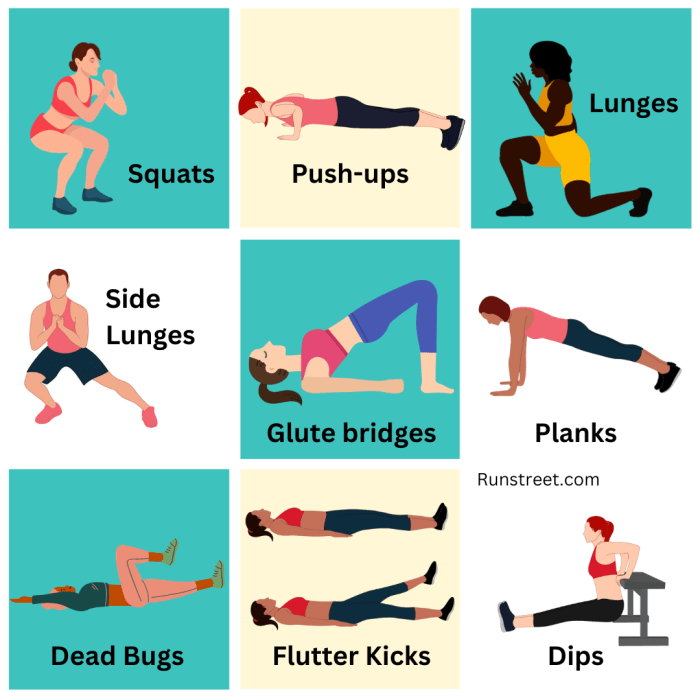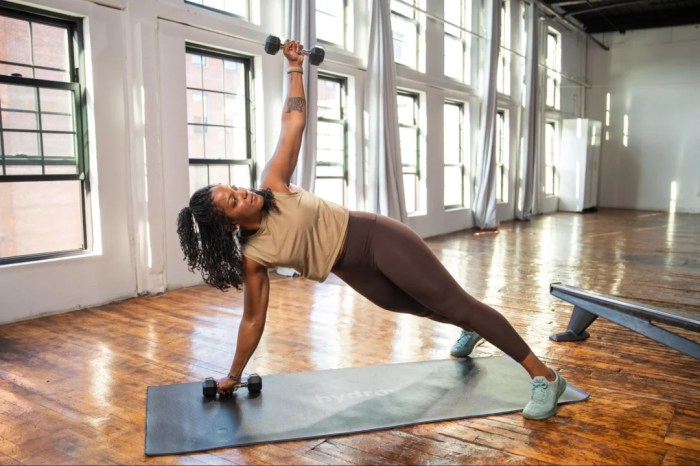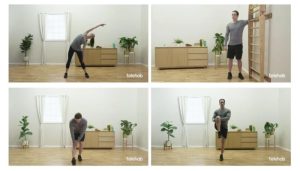
Ditch the gym membership fees and the awkward small talk with sweaty strangers! Home workout routines are exploding in popularity, transforming living rooms into personal fitness sanctuaries. Forget the treadmill hamster wheel; we’re talking about workouts that are as diverse as your Netflix queue, from yoga flows that’ll make you feel like a graceful gazelle to HIIT sessions that’ll leave you gasping for air (in a good way, of course!).
This guide dives headfirst into the world of home workouts, exploring everything from finding the perfect routine to staying motivated enough to actually do it.
We’ll uncover the secrets to crafting a workout plan that fits your lifestyle (and your available space!), explore the essential (and surprisingly affordable!) equipment you’ll need, and tackle the age-old question: how do you actually stick to a home workout routine when your couch is whispering sweet nothings in your ear? Get ready to sweat, laugh, and maybe even discover a hidden talent for burpees (we won’t judge).
Popularity and Trends of Home Workout Routines
The home workout revolution is in full swing, transforming how we approach fitness. No longer a niche activity, working out at home has exploded in popularity, leaving even the most dedicated gym-goers wondering if their monthly membership is worth the hassle. This shift reflects a broader change in lifestyles and priorities, with convenience and cost-effectiveness playing major roles.Home workout routines have become incredibly diverse and sophisticated, moving far beyond simple jumping jacks and sit-ups.
The rise of fitness influencers, readily available online resources, and technological advancements have democratized fitness, putting professional-level training within everyone’s reach. This accessibility, coupled with the flexibility it offers, is driving the trend’s phenomenal growth.
Factors Contributing to the Increasing Popularity of Home Workouts
Several key factors have propelled the popularity of home workouts. Convenience is a major draw; no more commutes, awkward gym schedules, or battling for equipment. The cost-effectiveness is undeniable; a single investment in some basic equipment can replace years of gym memberships. Furthermore, the increased privacy and comfort of working out in one’s own space appeal to many.
The rise of online fitness platforms, offering diverse classes and personalized programs, has also significantly broadened the appeal. Finally, the COVID-19 pandemic acted as a catalyst, forcing many to discover the benefits of home workouts and solidifying its place in the fitness landscape.
Comparison of Home Workout Routines and Gym-Based Workouts
Home workouts offer unparalleled convenience and affordability, allowing individuals to tailor their fitness routines to their specific needs and schedules. However, they may lack the variety and specialized equipment found in gyms. Gyms provide a structured environment with access to a wider range of equipment, expert guidance (often), and a motivating community atmosphere. However, they come with the costs of membership, travel time, and potential scheduling conflicts.
Ultimately, the best choice depends on individual preferences, resources, and fitness goals.
Top 5 Most Popular Home Workout Types in 2024
The following table highlights the top five most popular home workout types in 2024, based on current trends and online search data. These reflect a diverse range of preferences, from high-intensity interval training (HIIT) to the calming practice of yoga.
| Workout Type | Key Features | Equipment Needed | Intensity Level |
|---|---|---|---|
| High-Intensity Interval Training (HIIT) | Short bursts of intense exercise followed by brief recovery periods. | Minimal; often just bodyweight. | High |
| Yoga | Focuses on flexibility, strength, and mindfulness. | Mat; optional blocks and straps. | Low to Moderate |
| Bodyweight Training | Utilizes bodyweight as resistance; highly adaptable. | Minimal; often just floor space. | Moderate to High |
| Pilates | Emphasizes core strength, flexibility, and control. | Mat; optional reformer. | Moderate |
| Strength Training (with dumbbells/resistance bands) | Builds muscle mass and strength using weights or resistance. | Dumbbells, resistance bands; adjustable weights. | Moderate to High |
Types of Home Workout Routines
So, you’ve decided to ditch the gym membership and embrace the glorious world of home workouts? Fantastic! But with so many options swirling around like a Zumba class gone wild, choosing the right routine can feel overwhelming. Fear not, aspiring fitness guru! This section breaks down the different types of home workouts, catering to all fitness levels and goals, so you can find your perfect sweat-fest.Home workout routines can be broadly categorized based on their primary focus: building strength, boosting cardiovascular health, or enhancing flexibility.
Each type offers unique benefits and requires a slightly different approach. A well-rounded fitness plan, however, typically incorporates elements of all three.
Strength Training at Home
Strength training builds muscle mass, increases metabolism, and boosts overall strength. It’s all about challenging your muscles with resistance. At home, this can be achieved using bodyweight exercises, resistance bands, or readily available household items like water bottles.
- Beginner: Bodyweight exercises like squats, push-ups (against a wall initially!), lunges, and planks. Aim for 2-3 sets of 10-12 repetitions for each exercise.
- Intermediate: Incorporate resistance bands for added challenge in exercises like bicep curls, triceps extensions, and rows. Increase sets to 3-4 and reps to 12-15.
- Advanced: Utilize heavier resistance bands, or even improvise weights using filled water jugs or backpacks. Consider more advanced variations of exercises, like pistol squats or plyometric push-ups. Aim for 4-5 sets of 15-20 repetitions.
Cardiovascular Workouts at Home
Cardiovascular exercise gets your heart pumping, improving cardiovascular health, burning calories, and boosting endurance. The beauty of home cardio is the sheer variety available.
- Beginner: Start with brisk walking or jogging in place for 20-30 minutes. Jumping jacks, high knees, and butt kicks are also great options.
- Intermediate: Increase the intensity and duration of your cardio sessions. Try incorporating interval training, alternating between high-intensity bursts and periods of rest or lower intensity. Consider using a jump rope.
- Advanced: Explore more intense cardio routines like HIIT (High-Intensity Interval Training) workouts found online, incorporating burpees, mountain climbers, and sprint intervals. Aim for longer durations and higher intensity.
Flexibility and Mobility Workouts at Home
Flexibility and mobility exercises improve range of motion, reduce the risk of injury, and promote relaxation. Yoga and Pilates are excellent choices, but even simple stretches can make a huge difference.
- Beginner: Focus on basic stretches, holding each for 30 seconds. Include stretches for major muscle groups like hamstrings, quads, calves, chest, and shoulders.
- Intermediate: Explore more dynamic stretches, incorporating movements like arm circles and leg swings. Consider incorporating yoga or Pilates routines for beginners.
- Advanced: Practice advanced yoga or Pilates poses. Hold stretches for longer durations and focus on improving your flexibility in specific areas.
Sample Weekly Home Workout Plan
This plan combines strength training, cardio, and flexibility for a balanced approach. Remember to listen to your body and adjust the intensity as needed.
- Monday: Strength Training (Upper Body)
- Tuesday: Cardio (30 minutes)
- Wednesday: Flexibility and Mobility (Yoga or stretching)
- Thursday: Strength Training (Lower Body)
- Friday: Cardio (30 minutes)
- Saturday: Active Rest (light walk or stretching)
- Sunday: Rest
Remember to consult your doctor before starting any new workout routine.
Equipment Needed for Home Workouts

So, you’ve decided to ditch the gym membership and embrace the glorious world of home workouts. Fantastic! But before you leap into a series of triumphant burpees, let’s talk about the tools of the trade. Getting the right equipment can make all the difference between a productive sweat session and a frustrating flop. Remember, even a small investment can significantly improve your home workout experience.
The beauty of home workouts is the flexibility. You don’t need a mountain of equipment to get a killer workout. We’ll break down what’s essential, what’s nice-to-have, and how to cleverly substitute pricey gym equipment with affordable alternatives. Think of this as your guide to creating your own personal fitness empire, one affordable piece of equipment at a time.
Essential Home Workout Equipment
This is your core team – the equipment that truly forms the bedrock of a successful home workout routine. Investing in these items will provide a solid foundation for a variety of exercises, ensuring you’re equipped for success.
- Yoga Mat: Provides cushioning and grip for floor exercises, protecting your joints and preventing slippage. Think of it as your personal workout sanctuary.
- Resistance Bands: These versatile tools add resistance to your workouts, allowing you to target specific muscle groups and increase intensity without the need for weights. They’re incredibly portable and easy to store.
- Jump Rope: A simple yet highly effective piece of cardio equipment. It’s great for improving cardiovascular health, coordination, and burning calories. Plus, it’s a fun way to add some variety to your routine.
Optional but Highly Recommended Home Workout Equipment
These items elevate your workout game, adding more variety and challenge to your routines. While not strictly necessary to get started, they significantly enhance the effectiveness and enjoyment of your home workouts.
- Dumbbells: Offer a versatile way to add resistance to a wide range of exercises, from squats and lunges to bicep curls and shoulder presses. Consider adjustable dumbbells to save space and money.
- Kettlebell: A fantastic tool for building strength and improving overall fitness. It combines cardio and strength training, making it a highly efficient piece of equipment.
- Exercise Ball (Stability Ball): Engages your core muscles during various exercises, improving balance and stability. It can also be used for stretching and flexibility exercises.
Affordable Alternatives to Expensive Gym Equipment
Let’s face it, some gym equipment can cost a fortune. Fortunately, there are plenty of creative and cost-effective alternatives available.
- Water Bottles or Filled Bags as Weights: Perfect for beginners or for exercises where heavy weights aren’t needed. Just fill them with water or sand for adjustable weight.
- Using Your Own Bodyweight: Believe it or not, your body is the ultimate piece of workout equipment! Bodyweight exercises like push-ups, squats, and lunges are incredibly effective.
- Household Items: Get creative! Chairs can be used for dips, stairs for step-ups, and sturdy cans can substitute for light weights.
Comparison of Home Workout Equipment and Costs
Imagine a table. The first column lists the equipment: Yoga Mat, Resistance Bands, Jump Rope, Dumbbells (adjustable), Kettlebell, Exercise Ball. The second column shows a cost range for each item. For example, a yoga mat might range from $10-$50, resistance bands from $15-$30, a jump rope from $5-$20, adjustable dumbbells from $50-$150, a kettlebell from $20-$80, and an exercise ball from $15-$40.
The visual representation would highlight the range in cost, showing that some items are significantly cheaper than others. It would visually demonstrate how you can build a functional home gym on a budget, choosing the most essential items first and gradually adding more as your budget allows. The table emphasizes the significant cost difference between adjustable dumbbells and other cheaper alternatives, helping to visually illustrate the point of affordable substitutes.
Designing a Safe and Effective Home Workout Plan
So, you’ve decided to ditch the gym membership and embrace the glorious world of home workouts. Fantastic! But before you leap into a series of burpees that would make a Navy SEAL weep, let’s talk strategy. Designing a safe and effective home workout plan is crucial to avoid injury and maximize results. Think of it as building a house – you wouldn’t start laying bricks without a solid foundation, would you?Proper warm-up and cool-down routines are essential components of any workout, home-based or otherwise.
They prepare your body for the physical demands ahead and help prevent injuries. Neglecting these steps is like trying to run a marathon without stretching – a recipe for disaster.
Proper Warm-up and Cool-Down Routines
A good warm-up increases blood flow to your muscles, lubricating your joints and preparing your cardiovascular system for exertion. Think dynamic stretches like arm circles, leg swings, and torso twists, lasting about 5-10 minutes. Conversely, a cool-down helps your body gradually return to its resting state, reducing muscle soreness and promoting recovery. Static stretches, holding each stretch for 20-30 seconds (like hamstring stretches or quad stretches), are ideal for cool-downs.
Imagine your body as a finely tuned engine – a proper warm-up gets it revved up, and a cool-down allows it to cool down smoothly, preventing overheating and potential damage.
Progressive Overload in Home Workouts
Progressive overload is the cornerstone of any successful fitness program. It simply means gradually increasing the demands placed on your body over time. This could involve increasing the weight you lift, the number of repetitions you perform, the number of sets, or the intensity of your workouts. For example, if you started with 10 push-ups, gradually increase to 12, then 15, and so on.
It’s about consistently challenging your muscles to adapt and grow stronger. Don’t jump into a workout routine that’s too advanced too quickly; start slow and gradually increase the difficulty. Think of it like climbing a mountain – you wouldn’t try to summit Everest on your first hike!
Preventing Injuries During Home Workouts
Preventing injuries is paramount. Listen to your body – pain is a signal that something isn’t right. Don’t push through sharp or persistent pain. Maintain proper form during exercises. Watching videos and ensuring you understand the correct technique before attempting an exercise is crucial.
Using proper equipment and ensuring your workout space is safe and free of obstacles also minimizes risk. Think of it as driving a car; you wouldn’t drive recklessly, would you? The same principle applies to your workouts.
Modifying Exercises for Different Fitness Levels
Home workouts offer the unique advantage of easy modification. Beginners can start with easier variations of exercises and gradually progress to more challenging ones. For example, instead of full push-ups, you can do incline push-ups against a wall or a chair. For squats, you can start with bodyweight squats and gradually add weights or resistance bands. Individuals with physical limitations can adapt exercises to their capabilities.
For example, someone with knee problems might modify squats by performing chair squats or using a lower impact exercise like cycling. Remember, consistency and gradual progression are key; there’s no shame in starting slow.
Home Workout Routines and Health & Fitness

Regular home workouts offer a surprisingly potent punch to your overall health and fitness. Forget the gym membership fees and awkward stares – your living room can become your personal wellness sanctuary, transforming your body and mind in ways you might not expect. From shedding those extra pounds to boosting your mood, the benefits are surprisingly diverse and readily accessible.Home workouts significantly impact various aspects of health and fitness.
They provide a convenient and cost-effective way to improve cardiovascular health, build strength and endurance, and increase flexibility. The accessibility of home workouts makes it easier to maintain a consistent fitness routine, leading to long-term health improvements. This consistency is key, as sporadic bursts of activity are far less effective than a steady, regular approach.
Impact of Home Workouts on Overall Health and Fitness
Regular home workouts contribute to improved cardiovascular health by strengthening the heart and lungs, reducing the risk of heart disease, stroke, and other related conditions. Increased muscle mass, a common result of home strength training, boosts metabolism, aiding in weight management and improving bone density, reducing the risk of osteoporosis. Furthermore, regular physical activity, even at home, releases endorphins, acting as natural mood boosters and reducing stress and anxiety levels.
The cumulative effect is a noticeable improvement in overall well-being, encompassing physical and mental health.
Benefits of Home Workouts for Specific Health Conditions
Home workouts are particularly beneficial for managing weight. They can be tailored to individual fitness levels and goals, making them ideal for those looking to lose weight, maintain a healthy weight, or gain muscle mass. The flexibility of home workouts allows for consistent exercise, which is crucial for long-term weight management. For stress reduction, home workouts offer a convenient outlet for releasing pent-up energy and tension.
Activities like yoga, Pilates, or even a brisk walk around the house can significantly reduce stress hormones and promote relaxation. For individuals with mobility limitations, adapted home workout routines can help improve strength, flexibility, and balance, thereby enhancing their quality of life and reducing the risk of falls.
Comparison of Home Workouts with Other Fitness Approaches
While gym memberships offer access to a wider range of equipment and classes, home workouts provide equal, if not superior, results for many fitness goals, particularly when consistency is prioritized. The convenience and cost-effectiveness of home workouts often lead to higher adherence rates compared to gym memberships, which can be expensive and require travel time. For example, a person aiming to lose weight might find a home workout program, incorporating cardio and strength training, just as effective, if not more so, than attending expensive gym classes.
The key difference lies in the individual’s commitment and ability to create a sustainable routine.
Integrating Healthy Eating Habits with Home Workout Routines
To maximize the benefits of home workouts, integrating healthy eating habits is crucial. This isn’t about restrictive diets, but about making mindful food choices that support your fitness goals. For example, incorporating more fruits and vegetables into your diet provides essential nutrients to fuel your workouts and aid recovery. Choosing lean protein sources helps build and repair muscle tissue, while reducing processed foods, sugary drinks, and excessive unhealthy fats contributes to overall health and weight management.
A balanced diet, combined with regular home workouts, creates a synergistic effect, accelerating progress toward your fitness goals. Consider keeping a food diary to track your intake and ensure you’re consuming enough calories and nutrients to support your activity level. Planning meals in advance can also help avoid impulsive unhealthy food choices.
Maintaining Motivation and Consistency
Let’s face it, the allure of the couch is a powerful opponent in the battle for fitness. Staying motivated for home workouts isn’t just about willpower; it’s about strategy, understanding your own tendencies, and creating a system that works foryou*. This section will arm you with the tools to conquer those Netflix-induced workout postponements and finally achieve your fitness goals.
Common Challenges in Maintaining Consistency
The path to fitness nirvana is rarely paved with perfectly executed workout plans. Many common hurdles can derail even the most enthusiastic beginner (or seasoned pro!). Understanding these obstacles is the first step to overcoming them. For example, life often throws curveballs – unexpected work deadlines, family emergencies, or even just plain old fatigue can easily disrupt a meticulously planned routine.
Additionally, the lack of external accountability found in a gym setting can make it easier to skip a workout without feeling the social pressure. Finally, the initial excitement of a new routine can fade, leading to a decline in motivation. This is completely normal, but recognizing it is crucial for proactive management.
Strategies for Staying Motivated and Overcoming Obstacles
Staying motivated requires a multifaceted approach. One effective strategy is to find a workout buddy, even if it’s just a virtual one. Connecting with someone else who shares your fitness goals can provide support and encouragement. Another key is to diversify your workouts. The monotony of the same routine can quickly lead to boredom.
Experiment with different types of exercises, music playlists, or even workout locations within your home to keep things fresh. Finally, celebrate small victories! Don’t wait for the big milestones. Acknowledge and reward yourself for every workout completed, no matter how small. This positive reinforcement can make a huge difference in maintaining long-term motivation.
Setting Realistic Goals and Tracking Progress
Setting ambitious goals is fantastic, but unrealistic expectations can lead to disappointment and demotivation. Instead of aiming for a complete body transformation in a month, focus on smaller, achievable goals. For example, commit to working out three times a week for the first month, then gradually increase the frequency or intensity. Tracking your progress is essential. This could involve using a fitness app, a simple journal, or even a wall calendar to mark off completed workouts.
Visualizing your progress can be incredibly motivating, providing a tangible reminder of your accomplishments. Think of it like leveling up in a video game – each workout completed brings you closer to your ultimate goal.
A Motivational Plan: Reward Systems and Accountability Measures
A comprehensive motivational plan needs both carrots and sticks (metaphorically speaking, of course!). Reward systems are crucial. After achieving a specific goal (e.g., completing a week of workouts), reward yourself with something you enjoy – a new workout outfit, a relaxing bath, or a delicious healthy meal. Accountability measures are equally important. This could involve sharing your fitness goals with a friend or family member, joining an online fitness community, or even hiring a personal trainer (even virtually!).
The key is to find a system that keeps you honest and motivated. Consider creating a contract with yourself, outlining your goals, rewards, and consequences for missing workouts. This formal commitment can significantly increase your adherence to your plan.
Resources and Further Information
So, you’ve conquered the world of home workouts – or at least, you’re on your way! But the journey to fitness nirvana doesn’t end with a perfectly planned routine. Knowing where to find reliable information and support is just as crucial as nailing that perfect plank. Think of this section as your personal fitness sherpa, guiding you through the digital Himalayas of workout wisdom.This section provides a roadmap to reputable online resources and explains why checking in with a healthcare professional is a non-negotiable step before embarking on any new fitness adventure.
We’ll cover some excellent online resources, apps, and websites that can help you stay motivated and informed. Remember, safety first!
Reputable Online Resources for Fitness Information
Finding trustworthy fitness advice online can feel like searching for a needle in a haystack – except the haystack is made of protein shakes and questionable workout tips. To help you avoid the fitness misinformation swamp, we’ll highlight the characteristics of reliable resources. Look for websites and platforms backed by certified professionals, offering evidence-based information, and avoiding overly sensationalized claims promising unrealistic results.
A good resource will prioritize your safety and long-term health over quick fixes. Think reputable fitness magazines, university health websites, and organizations dedicated to exercise science.
Helpful Fitness Apps and Websites
Imagine having a pocket-sized personal trainer, nutritionist, and motivational speaker all rolled into one! That’s the power of fitness apps and websites. Many offer personalized workout plans, track your progress, provide educational content, and even connect you with online communities for support and accountability. Some focus on specific fitness goals (yoga, strength training, HIIT), while others offer a more holistic approach, incorporating nutrition and mindfulness practices.
Look for apps and websites with positive user reviews and a strong emphasis on safety and proper form. Remember to check the app’s privacy policy before signing up.
Consulting Healthcare Professionals Before Starting a New Workout Routine
Before you launch into your brand-new home workout regime, it’s essential to consult with your doctor or a qualified healthcare professional. This isn’t just about avoiding injury; it’s about ensuring your workout plan aligns with your individual health needs and limitations. They can assess any pre-existing conditions, advise on appropriate exercise intensity, and help you identify potential risks. Think of it as preventative maintenance for your body – a small investment that can pay huge dividends in the long run.
Ignoring this step could lead to setbacks and potentially serious health issues. Your health is your most valuable asset; don’t risk it!
Conclusion
So, there you have it – a comprehensive guide to conquering your fitness goals from the comfort of your own home. Remember, the journey to a healthier, fitter you is a marathon, not a sprint (unless you’re doing sprints, in which case, go for it!). Embrace the flexibility, affordability, and sheer convenience of home workouts. Find what works for you, celebrate your progress, and don’t forget to hydrate! Now get out there (or stay in there, rather) and unleash your inner fitness guru.
Key Questions Answered
Can I build muscle with home workouts?
Absolutely! With proper progressive overload (gradually increasing weight or resistance) and a focus on compound exercises, you can definitely build muscle at home.
How often should I work out at home?
Aim for at least 2-3 workouts per week, allowing for rest days to recover. Listen to your body and adjust as needed.
What if I don’t have any equipment?
Bodyweight exercises are incredibly effective! You can achieve great results with just your own body weight as resistance.
Are home workouts as effective as gym workouts?
They can be just as effective, depending on your goals and the intensity of your workouts. The key is consistency and proper form.





